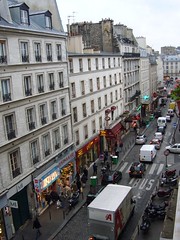19/01/07
Rue du Faubourg du Temple
I’m not yet tired of Parisian street-life. That’s good, because it’s only four floors separating my bedroom-cum-office from a very noisy, or let’s rather say lively, street indeed.
Rue du Faubourg du Temple, view from my window.
Rue du Faubourg du Temple runs, as I’ve already mentioned, between the significant places Place de la République - where an enormous bronze Marianne La République resides with the three strong marble ladies La Liberté, L’Égalité and La Fraternité – and Belleville. Most demonstrations of whatever size start at Place de la République. When I lived next to the square for a fortnight in December, I stumbled upon a substantial number of police cars right outside my gate every third day or so. One day it was no less than 16 vans from the CRS, another day just 10 or so from La Gendarmerie, and yet another it was the Police Nationale. Only at one of the occasions did I see the demonstrators. The same happened actually a couple of days ago. I had read at Paris.Indymedia that the college students and the sans-papiers would demonstrate against the immigrations policies, so I went over to see what was happening. Maybe I was too late, because at the time I arrived there was very few lycéens to see. On the other hand, the forces of order were heavily represented; the CRS with at least 15 vans, a bus and some other equipment were creating a noisy traffic jam driving south-east down Avenue de la République (direction Père Lachaise and perhaps Place de la Nation). The demonstrations of national importance usually go between Place de la République to Place de la Nation, via Bastille – thus it’s not only the police who can stage a political struggle symbolically (however, with their Robocop uniforms they’re hard to beat when it comes to costumes).
A few demonstrations start other places than at République. According to my flatmate, there is one passing down Faubourg du Temple about every second week. Judging from the slogans he mimicked, it usually concerns les sans-papiers, which is reasonable since it’s coming from Belleville/the East and going to Place de la République. I actually joined one of these demonstrations (described here), just a few weeks after arriving in Paris the previous autumn. Funnily, I took a photo of the building I’m now living in, because of the nice flowerpots and the Chinese restaurant at the ground floor. And that makes the transition to the next point in this post.
The restaurant in this building seems almost to be an outpost for the higher concentration of Chinese restaurants and shops a little up the street in Belleville. Down here, Pakistani shops are at least as numerous. For some strange reason, many Pakistanis in Paris run these cheap, thrashy plastic utensil etc. shops (I have no idea what to call this genre of shops in English). I’ve seen them everywhere in East working-class Paris, and most of them seem to be Pakistani owned. One can probably find some neat Fredrik Barthian explanation for why the Pakistanis have ended up in this particular ethnic niche in this city. Neither in London, nor in Oslo is that the case. Interestingly, it was in neither British hip-hop nor Norwegian, but French, that I was to hear the first sample of a Bollywood song (Rohff (Rohff on last.fm here): Bollywood style.)
The highest presence of Pakistanis is at the other side of Place de la République, in the direction of Gare de Nord. While I’ve just seen one not very conspicuous Bollywood video sale and rental around here, on the other side of République there are more, until you get some street which are almost exclusively Indian, Pakistani and Sri Lankan. (According to Le Monde à Paris – in the nicely titled guide series Paris est à nous (“Paris is ours”) – from 2004, there are 50 000 from the subcontinent in Paris. – One guesses that there is equally many Chinese clandestines here, in addition to the 450 000 who are registrered).
As usual when I start writing a post, I quickly lose focus of the initial idea and the post end up wandering about. I had no intention at all to write about the police again, for instance. This blog post was in fact inspired by a quick walk up the road and the no less than overwhelming amount of impressions it inspired – including the initial thought that opened this post; the Paris street life never stops intriguing me…. I’ve discussed the bad winter mood of the Parisians with a couple of people lately. – They rarely smile, many are arrogant or aloof and the level of aggression and nervousness is high. (For instance, often when I approach a young woman on the street to ask for a direction, she first looks visibly anxious before she notices that I’m just another young woman). – When a friend of mine explained this mood by referring to sheer dense materiality of this city – “packed as sardines on the metro, the person next to you just wished you weren’t there” – it echoed Dag Østerberg’s “socio-material interpretation of Oslo”, which I’d just been reading. Paris is far denser than Oslo, and people behave very differently on the street here. Whether it comes down to a material explanation, I don’t know. It can also have something to do with sexism and different gender relations, with revolutions and education for revolts, with a continuous construction of “living together” through talking to each other (a bit à la Cicero’s republic perhaps) etc… all of which I’ve touched upon here before and which I’ll undoubtedly return to. However not now, as this post has become long enough.
No feedback yet
| « Sunny Sunday – cycling and les techniques du corps | Intermezzo » |


